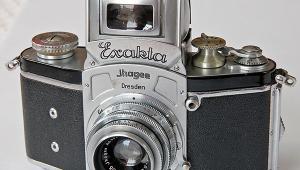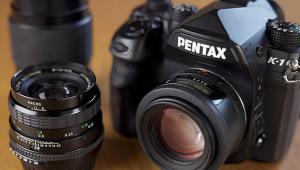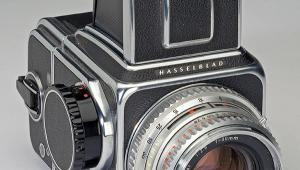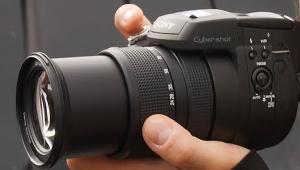The “User Collectible” NPC 195: ...With Fuji Instant Film
Limited production, exquisite fit and finish, and usability, too: how much more does it take to qualify a camera as a classic, or a collectible? Maybe a good dash of eccentricity; and the NPC 195 qualifies on all counts.

All Photos © Roger Hicks Ltd.
The fortunes of NPC (Newton Plastics Corporation) rose and fell with those of Polaroid. They were probably best known to most photographers for their Polaroid proofing backs using the late Marty Forscher’s patents for optical-fiber transfer of the image, though they also made a superb tripod head of unique design (the Pro-Head), a microscope camera, and more. They did a lot of government work, including for NASA, but a few years ago, after decades of success, they closed their doors.
The NPC 195 is a reinterpretation of the old Polaroid 195. NPC managed to source the same lens as the Polaroid 195 (Tominon 114mm f/4.5) in a Copal 0 shutter, and an identical rangefinder-viewfinder unit, but they built their camera to use standard quarter-plate (3x4”) Polaroid pack films as well as the smaller amateur size, which was (I think) 3x3”. It is worth enumerating them to show what we have lost: Pro 100, 107C, 108 Polacolor ER, 611 B+W, 612 ultrahigh-speed (ISO 20,000!) high-contrast B+W, 664 B+W, 665 pos/neg, 667 high-speed coaterless, 668 Polacolor 2, and 669 Polacolor ER.

Fortunately, today, we can still get fully-interchangeable Fuji instant-picture films for these cameras, albeit with far less choice: last time I checked, just FP-100C (ISO 100 color), FP-100B (ISO 100 black and white), and FP-3000B (ISO 3000 black and white). For those for whom Polaroids (or today, Fuji instant pictures) have never lost their magic, the NPC 195 must be one of the most desirable cameras available. One day, we may yet see revived Polaroid peel-apart films from The Impossible Project, but so far, we have seen only “integral” (SX-70 and 600-series) from them.
The NPC 195 is a doppel-klapp, with front and rear standards linked by struts and bellows. In order to open or close or focus the camera, you really need to know how to use the thing, which means knowing which bits to press and squeeze when. It’s complicated enough that an illustration is needed to make it easier.

To open it, you lift up Button #1 on the front of the camera (under your right middle finger as it curls around the camera from the back). Yes, Button #1 is what it’s called in the instruction manual (two sheets of letter-size paper). That releases the struts and you can pull out the front standard until it clicks in place. To close it, on the other hand, you press down on the long, upper bar at the top (the one that connects the front panel to the back). You can now push the front standard back in.


Then there’s focusing. At the top of the camera, mostly inside the body and parallel with the back, there is a long metal bar with black plastic buttons on either end. Holding the camera to your eye, and looking through the tiny rangefinder window to the left of the viewfinder window, you use these to push the bar to the left (focus closer) or to the right (focus further away). There is no distance scale or depth of field scale: the rangefinder is the only way of telling whether you are in focus or not.
Fortunately it is both accurate and easy to use. The base length is 55mm and the magnification is 1:1 so the effective base length is the same. It is easy to use because it has a green field with a yellow patch that is just about sharp-edged enough to use as split-image as well as coincidence: many people find a split image, where you look for a discontinuity in a straight line, to be quicker and more accurate than plain coincidence, placing one image on top of the other.

Minimum focus distance is about 120cm, 4 feet, which corresponds to a side-to-side movement of the focusing bar of maybe 15mm or just over half an inch. Button #1, incidentally, is just above the right-hand focus slider button (as you are holding the camera ready to use).
After focusing, shift your eye to the right, to the viewfinder window: the bright-line frame moves up and down for parallax correction as the lens is focused. Viewfinder magnification is about 0.85x, just about close enough to 1:1 to allow you to keep both eyes open. What appear to be parallax compensation marks on the right are in fact for when you are using the small formats.
Apart from these complications, it’s very easy indeed to use, provided you know how to use a completely and utterly manual camera. The lens goes from f/4.5 to f/32 (equidistant markings after f/5.6, smooth movement, no detents), and the shutter is speeded 1 to 1/500 + B and T. That’s it: focus, aperture, shutter speed. Photography reduced to its essentials. There is absolutely no coupling between the shutter and the back: double exposures and blanks are equally easy.
Which is why it’s a cult camera. It’s for people who know what they are doing; who want a unique look; and who are prepared to pay for it. Its “poor relations,” the original Polaroid 195s, have to be converted to modern films and still go for several hundred dollars each.
Results? Suffice it to say that the lens is sharp and contrasty and will out-resolve anything you can put in the camera, except perhaps (if you can still find any, and if it still works) the negative of the old Polaroid pos/neg material, Type 665. After that, it’s simply a question of how much you like Fuji’s current peel-apart films, plus the immediacy of showing people “real” pictures instead of an image on the back of a camera. This is almost as much a novelty today as it was when Edwin Land introduced Polaroid photography in the late 1940s.
I don’t know how many NPC 195s were made, but I would be surprised if it were as many as a thousand in the seven or eight years they were in production, from 2000 to 2007 or 2008. Nor have I any real idea of what they are worth. At least $500, I suspect, and maybe $1000 or more, especially if they are complete with box, pouch, and instructions (all but essential unless you have read this article!). In fact, this particular camera has one more thing: an “ever-ready” case. That’s boxed, too. So maybe it’s ultra-collectible.
For further information on the art and craft of photography from Roger Hicks and Frances Schultz, visit their website at: www.rogerandfrances.com.
- Log in or register to post comments

















































